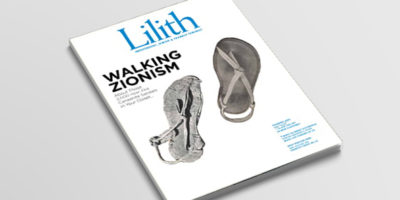“Gett” — The Film That’s Shaking Up Jewish Divorce

Ronit Elkabetz plays the role of Viviane Amsalem in “Gett.”
One gripping film is accomplishing what years of quiet struggle have failed to do: create a storm of outrage over the men-only Jewish religious divorce law. A religious divorce in a rabbinical court (beit din) is the one divorce available to Jews in Israel, and women are powerless to sue for divorce. Civil divorce does not exist.
If a husband refuses to divorce, or if he vanishes in war or otherwise, the wife is an “agunah,” a woman “chained,” forever unable to remarry. (This is true for Jewish divorces outside Israel, also, but elsewhere, civil marriage and divorce are the law of the land.) Even when a husband agrees to the divorce, his agreement may be based on the extortion of concessions from his wife.
The Israeli feature film “Gett: The Trial of Viviane Amsalem” has riled up Israelis to the point of pressuring the annual conference of Israel’s rabbinical judges to view the film in a private screening. (Israel’s Orthodox rabbis would not typically expose themselves to movies.) No surprise, the legal advisor to the rabbinic courts, Rabbi Shimon Yaakobi, said the film — which follows in agonizing detail the last two years of Viviane Amsalem’s five-year struggle to get her husband to give her a gett — a Jewish divorce decree — in no way reflected what happens in the real-life courts. “Gett” was made by sister-brother writers-directors Ronit and Shlomi Elkabetz, and stars Ronit, one of Israel’s leading actors. Israel’s 2015 Oscar entry for best foreign-language film, “Gett” is being screened in the U.S. to rave reviews and horrified audiences. [See Amy Stone’s post on the Lilith blog, “Get Thee to Gett.”]
Pushing for change, filmmaker Shlomi Elkabetz wants DVDs of “Gett” distributed to Orthodox women, and he sees the implementation of civil divorce as the answer to Israeli women’s powerless condition.
Much as we’d like to see “Gett” ignite a revolution, not so fast. In the words of Ruth Halperin-Kaddari, professor of law at Bar-Ilan University and director of the university’s Rackman Center for the Advancement of the Status of Women, “Israeli religion and state politics are a lot stronger than one movie.” She calls the Israeli population’s denial of women’s inferior status “the ‘no-problem’ problem.” This national mentality, embedded in marriage and divorce law, makes it possible to set women’s rights aside as less important than issues of national security.
In fact, Israel is the only Western country receiving a grade of zero on the “Freedom of Marriage World Map” published by the Israeli nonprofit Hiddush. With no civil or interfaith marriage or civil divorce, Israel’s score of zero puts it in the company of Afghanistan, Burkina Faso, Congo-Kinshasa, Iran, Pakistan, Saudi Arabia and Sudan.
So where will change come from?
The Center for Women’s Justice, located in Jerusalem, is using Israel’s civil court system to achieve justice for agunot. It was started by Susan Weiss, an American-born Israeli lawyer. Weiss is making legal inroads by suing recalcitrant husbands for human rights violations under tort law. She’s been successful in winning divorces and/or large awards for emotional damage for otherwise powerless women.
But male privilege as exemplified by the rabbinical court is not about to fade away. In the U.S., rabbinical organizations have established escape clauses in the ketubah, the Jewish wedding contract. But few
Orthodox Jews avail themselves of these halachically driven attempts at equal rights should a woman want to divorce.
Orthodox Jewish feminists who have spent decades devoted to the cause of freeing agunot see halachic change as the solution. As Blu Greenberg, founding president of JOFA, the Jewish Orthodox Feminist Alliance, wrote in Lilith some years ago, “Where there’s a rabbinic will, there’s a halachic solution.” She’s certainly been proven right applying that same patient reasoning in another respect — the opening of the gates for women to serve as Orthodox rabbis in almost all but name, although these pioneers are still controversial.
The institution holding out fresh hope is the International Beit Din (IBD), headed by highly respected Orthodox rabbi Simcha Krauss in the Riverdale section of the Bronx, New York City. The independent IBD, which heard its first case in August 2014, is dedicated to finding halachically acceptable ways to free these chained women. A trio of rabbis — Krauss,
A. Yehuda (Ronnie) Warburg and Yosef Blau — are delicately treading a path rife with pitfalls. In the past, highly regarded Orthodox rabbis determined to free agunot have failed to get other rabbis to accept their rulings.
In a breakthrough in transparency, the IBD promises to post its decisions online, in English, giving the halachic reasoning behind each judgment without revealing couples’ names. In another IBD innovation, female psychologists and social workers will be supporting the agunah throughout the proceedings.
While the IBD has already met with criticism from some Orthodox rabbis in the U.S. and Israel, those close to the issue are hopeful. Halperin-Kaddari says, “We’ll see if other courageous men will support the IBD and not be intimidated.” Although it’s still small, the IBD, Halperin-Kaddari says, “could create some competition. Rabbinical courts would find themselves much more accountable than they are now, and that would make a difference.”



